With the continual focus on aesthetics in the dental industry, a growing community of clinicians are looking to improve their technique when using composite. Many dentists are enjoying the results, and relishing the challenges faced along the way. One of the most common challenges is dealing with post-op sensitivity. So what are the main causes of post-operative sensitivity, and how can they be avoided?
This blog discusses some of the reasons for post-operative sensitivity when using adhesives and resin composites, and explains how Peak Universal Bond and Mosaic Universal Composite, both from Ultradent, are designed to reduce discomfort for patients, whilst offering superior handling and great aesthetic results.
“After restorations with resin composite, especially in posterior teeth, clinical observation has shown that patients complain of dentinal sensitivity at different levels and in different situations. This is a common problem, even with no visible failures in the restoration. Pain is always a warning signal of possible aggression, and although it does not have a direct relationship with the pathological processes, it is one of the most common reasons for seeking dental treatment, either in public service or private clinics.”
Source: Porto I, “Post-operative sensitivity in direct resin composite restorations: Clinical practice guidelines” (2012) Researchgate.

Post-op sensitivity in class Is, class IIs and young patients is a particularly common challenge. It is essential to keep the faith of the patient and if the patient is young, the parent also. Therefore, diagnosing the cause requires the correct amount of care and attention, especially as once the restoration is completed, the problem cannot be solved without removing the restoration and starting again.
Here are some of our top reasons for post-op sensitivity and some tips for best practice:
The dentine is too wet or overdried after etching using the total etch system
When the dentine is left too wet, this may cause microscopic water blisters and resin globules to occur inside the dentinal tubules. When under occlusal compression, these blisters then may force dentinal fluid toward the pulp and cause post-operative sensitivity.
When dentine is too dry, the surrounding collagen fibres collapse and it becomes difficult to impregnate the resin into the dentine; again causing sensitivity during chewing.
“There is no simple answer to the question of what is “too wet” or “too dry.” Thus, total-etch products are technique-sensitive. When used in the laboratory on flat dentin surfaces, one can obtain a relatively uniform surface “wetness.” Clinically, however, there is a tendency to over dry the pulpal or axial wall of complex cavities and to pool water at axial-gingival line angles, leaving the dentin surface with a nonuniform degree of wetness and nonuniform resin infiltration.”
Source: The Evolution of Dentin Bonding, Dentistry Today, Dr. Pashley
Over etching dentine
Etching dentine too long may result in etch patterns that extend too deep for the adhesive resins to reach the healthy tooth structure. Depths of about 2 to 2.5 µm are the limit; deeper etching creates voids that may result in a weak link or tooth sensitivity. Always use an etchant with a limited penetration depth, even when left longer than the recommended 15 seconds.
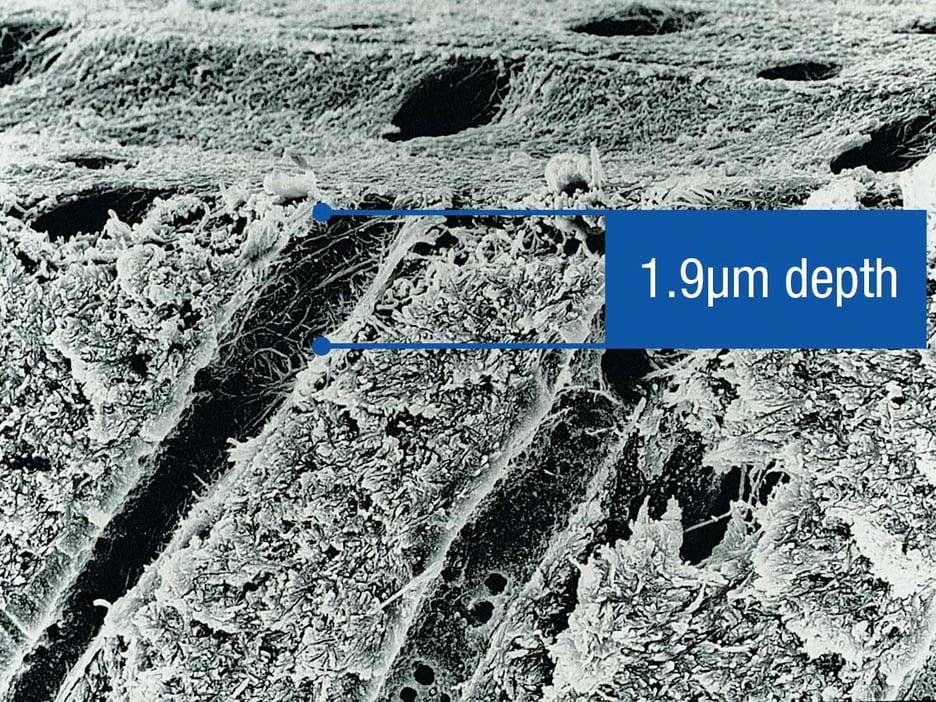
With an average depth of 1.9μm with a 15-second etch, Ultradent's Ultra-Etch stops etching at the ideal depth.
Under curing or over curing (cooking)
Under curing leaves the bonding resin only partly polymerised, which again leads to sensitivity. It is important that your curing light is powerful enough to reach the full distance from the tip of the light to base of the cavity. Use high energy lights with at least 400Mw/cm2, or preferably over 1.000 Mw/cm2
Over curing also has its pit falls. A study carried out in 2006 (1) looked at the thickness of the oxygen inhibited layer with varying amounts of light applied to the adhesive layer resin under direct fill composites. The adhesive resin layer was cured longer than recommended by the manufacturer, resulting in a higher degree of conversion and a thinner oxygen inhibited layer. The findings showed that on the thinner oxygen inhibited layer, defects occurred between the adhesive layer and the composite resin, and that a thick oxygen inhibited layer produced better bond to the curing composite. The lesson? Always follow the manufacturer’s guidelines for curing times.
Etching deep dentine in class ones with phosphoric acid
As in total-etch procedures, phosphoric acid etchant is applied to etch the dentine and needs to be rinsed and dried. In deep dentine, overdrying the collagen layer and thus collapsing the fibres in the intertubular dentine prevents the adhesive from penetrating correctly. As mentioned before, this collapse of the collagen fibres is a major cause of post-operative sensitivity. In self-etch, the etching depth and the depth of the adhesive’s penetration into the dentine is the same, meaning the collagen fibres are prevented from collapsing.
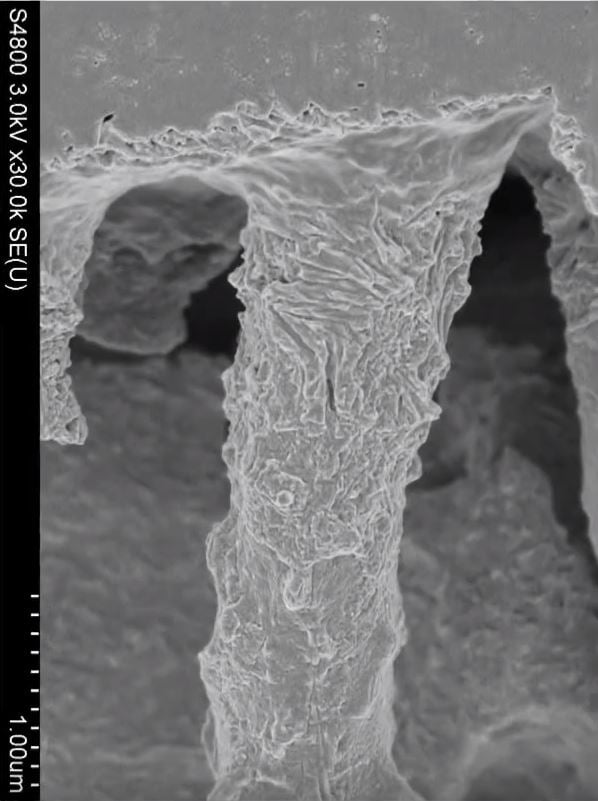
Sem showing flow down the tubules. Image courtesy of Ultradent.
Curing before correct application of the adhesive
Allowing too little time for application of the adhesive may result in poor penetration of the bonding agent. Make sure the rubbing, brushing in and agitating of the product all takes place. It is also important to air thin the product to allow the solvent to evaporate. If the curing light is used before the solvent evaporates, this may result in an incomplete cure.
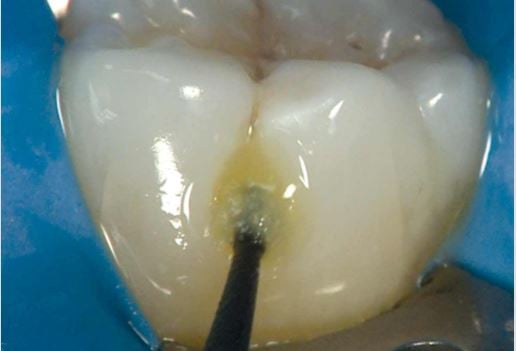
Peak Universal Bond is delivered to the preparation site with the applicator brush. Image courtesy of Ultradent.
How does Peak Universal combat sensitivity?
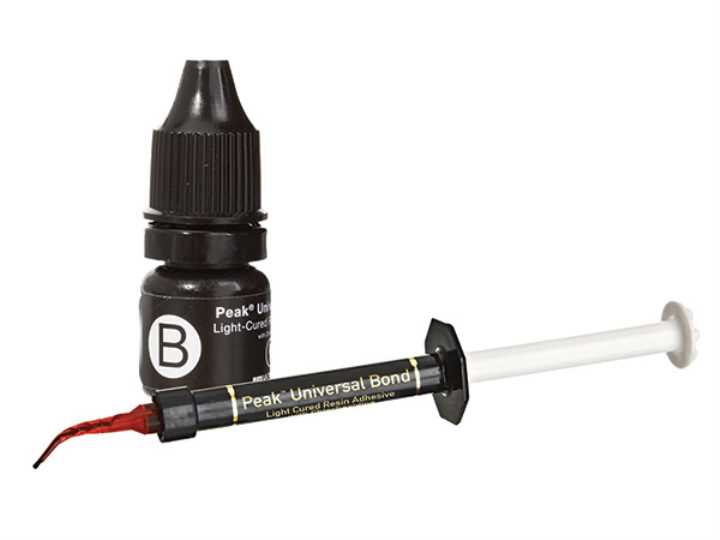 “I have used the Peak bonding system exclusively for the last four years with great success. There are two reasons for my faithfulness to Peak. First, patients never have post-operative sensitivity. Secondly, the syringe with brush tip is incredibly convenient. Great product!”
“I have used the Peak bonding system exclusively for the last four years with great success. There are two reasons for my faithfulness to Peak. First, patients never have post-operative sensitivity. Secondly, the syringe with brush tip is incredibly convenient. Great product!”
Dr. Brad McConnell
Neil Jessop, Director of Research and Development at Ultradent says, “We have chemistry inside (Peak) that allows us to have a priming type agent. This primer allows us to have a wettable, or hydrophilic type component that goes in and finds the most microscopic details you can imagine, while after being polymerised becomes substantially hydrophobic. This ensures a long term bond, really dealing with sensitivity well”
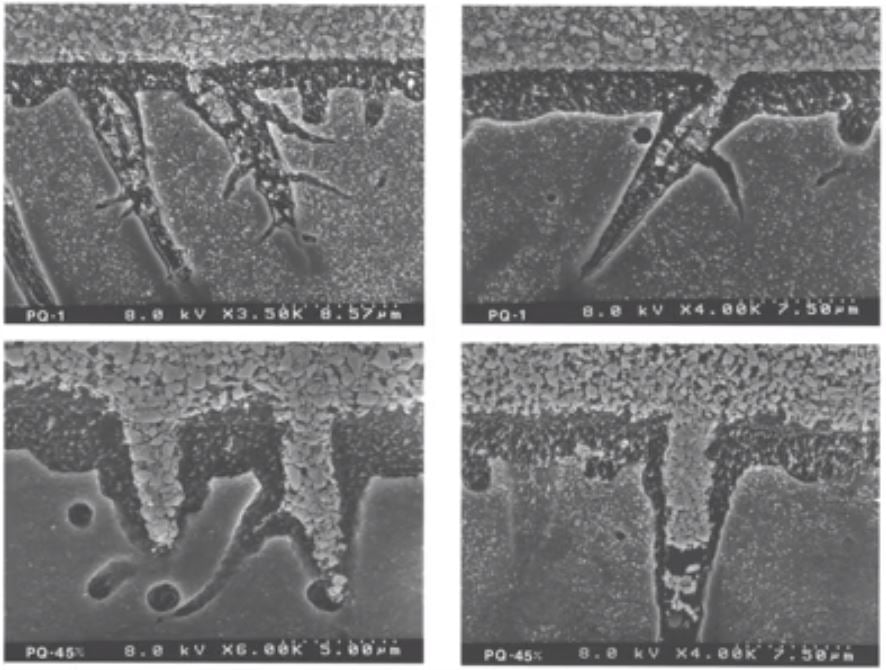
It is the ability of Peak Universal bond to fill in the microscopic spaces which helps to the stop sensitivity experienced when hydraulic pressure is put onto the tubules. Image courtesy of Ultradent.
As well as tackling sensitivity, Peak came out top in a recent study. The microshear bond strength (μSBS) of several universal adhesive systems was tested by application onto five different indirect restorative materials. The study, held by top names in adhesion globally; Dr. Loguercio and Dr. Perdigao among others, proved that:
Peak Universal Bond to be the only adhesive for which the mean μSBS reached the highest ranking of statistical significance for all five substrates. (2)
Peak Universal can be used for self etch and total etch techniques. It bonds to dentine, enamel, porcelain, metal, composite and zirconia and as it contains chlorhexidine ( 0.2%), this may ensure long term bond strength.
“I haven’t had to replace a restoration due to patient sensitivity since I started using the Peak bonding system over 5 years ago. I use Peak exclusively and recommend it highly to all my colleagues!”
Dr. Thomas Germino
How does Mosaic combat sensitivity?
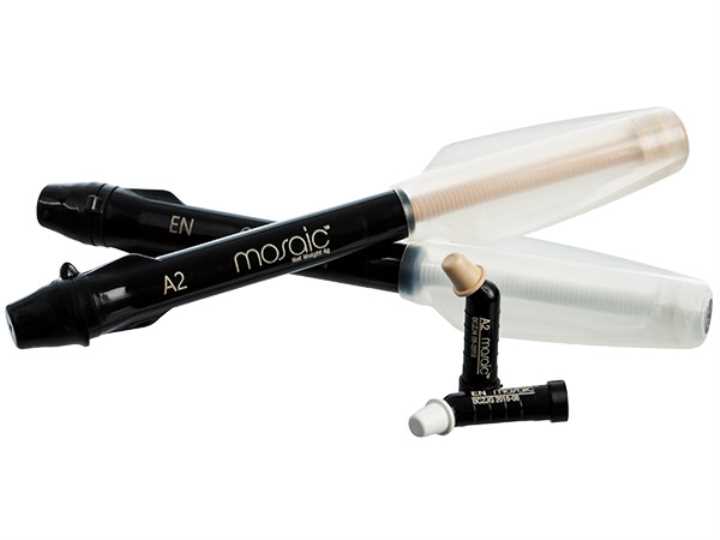 Many composites present some level of shrinkage once cured, and shrinkage stress can weaken the bond between the composite material and the tooth; leading to marginal gaps, microleakage and the post-op sensitivity. As class I and II restorations have the greatest number of bonded surfaces, they most susceptible to the effects of shrinkage stress.
Many composites present some level of shrinkage once cured, and shrinkage stress can weaken the bond between the composite material and the tooth; leading to marginal gaps, microleakage and the post-op sensitivity. As class I and II restorations have the greatest number of bonded surfaces, they most susceptible to the effects of shrinkage stress.
Often named as universal, the nano-hybrid is the newest development in the industry. One of the characteristics of a nano-hybrid is that it has low shrinkage, therefore helping to eliminate chances of marginal gaps forming after polymerisation.
As Mosaic is a nanohybrid composite, it not only has low shrinkage, but it also performs well when it comes to aesthetics, wear characteristics and polishability.

Class II restoration using the Peak Universal Bond adhesive system with Mosaic composite shades A5 and Enamel Neutral.
Photos courtesy of Dr. Gaetano Paolone.
Containing three different sized particles, nanohybrids combine the benefits of microfilled composites (which possess tiny particles to create high shine but lack strength), with the larger particles of hybrid composites (which offer good strength but give a less polishable, more matte finish).
“Love the way the material handles and I love the realistic and beautiful look…Mosaic composite is a WINNER! Can’t wait to do more cases!”
Dr. Hal Stewart
Be prepared for the switch
As patients drive the demand for realistic looking restorations in the pursuit to look their best, the requests to replace amalgam fillings with new and more modern composite solutions are also growing. As amalgam doesn’t have the same post-operative sensitivity implications as composite, the use of adhesives with resin composites comes under the spotlight once again.
Both Peak Universal Bond and Mosaic Universal Composite have been carefully designed to ensure minimal sensitivity is experienced. Why not make the switch to something effective, clinically proven and designed to work for you?
For more information, to buy, or to arrange a practice visit call 01943 605050 or email sales@optident.co.uk.
References
(1) Kim JS1, Choi YH, Cho BH, Son HH, Lee IB, Um CM, Kim CK. Effect of light-cure time of adhesive resin on the thickness of the oxygen-inhibited layer and the microtensile bond strength to dentin. J Biomed Mater Res B Appl Biomater. 2006 Jul;78(1):115-23.
(2) Siqueira F, Cardenas AM, Gutierrez MF, Malaquias P, Hass V, Reis A, Loguercio AD, Perdigão J. J Adhes Dent. Laboratory Performance of Universal Adhesive Systems for Luting CAD/CAM Restorative Materials 2016;18(4):331-40. doi: 10.3290/j.jad.a36519

